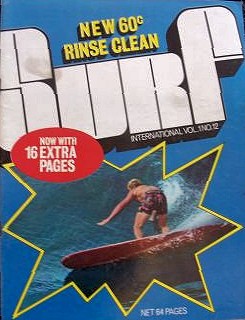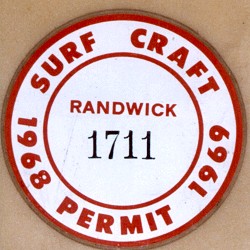SPECIFICATIONS
CONSTRUCTION
Stringerless foam
blank, Volan glassed with 2 inch rail lap, deck patch ???, internal fin
rovings - covered by black gel resin, post-production legrope plug. Surfcraft
Registration Sticker
DIMENSIONS
|
Length:
|
8
|
feet |
1/2
|
inches |
|
|
|
Width:
|
22
3/4
|
inches |
|
Wide
Point:
|
+ 9
|
inches |
|
Nose
:
|
17
1/2
|
inches |
|
Tail:
|
14
|
inches |
|
Thickness:
|
x
|
inches |
|
Pod:
|
0
|
inches |
|
Weight:
|
|
kilos |
|
Volume:
|
|
litres |
|
Nose/L:
|
|
inches |
|
Tail/L:
|
|
inches |
|
Other
|
|
|
|
|
|
|
FEATURES
Nose:
Rounded
pin
Tail:
Pin
- definitely at original construction, currently a repaired small square
tail.
Deck:
Rolled
Bottom:
light
roll
Rails:
50/50
pinched
Rocker: gentle
with slight nose lift |
NOTES
BOARD HISTORY
Source : Albion
Park Rail, NSW - no available history???
Purchased by ???,
August 2004.
Dimensions and photographs
Mollymook Malibu Charity Contest, 14 August 2004 (Rennie's Beach)
Deck heavily waxed,
.bottom dirty, repaired dings to nose, tail and bottom.
MANUFACTURER HISTORY
See Hayden
Surfboards
SHAPER HISTORY
Althougn credited with the introduction
of the shortboard with the Vee bottom Stubby design of 1967, Bob McTavish
shaped an 8ft 4'' pintail design with Ted Spencer at Keyo Surfboards during
1967 - "Little Red".
Ted Spencer won the Windansea Contest,
Palm Beach in 1967 on the board (see The Fantastic Plastic Machine)
and then took it to Hawaii for the 1967-8 winter (see The Hot Generation).
Image left :
Bob McTavish and Litle Red, Honolua
Bay, Maui, 1967-8.
Surf International Magazine
Volume 1 Number 12, circa 1969.
Photograph by John Witzig
Click for further details. |
 |
DESIGN HISTORY
Following the failure
of the wide-tailed Vee bottom experiment in Hawaii December1967 plan shapes
became the focus of design
In early 1968 some
designs merely added a pintail - the Pintail Vee bottom - see
#107
This was quickly
abandoned, and as the year progressed plan shapes literally reversed to
a fully foiled gun derived template.
Wide points moved
dramatically forward (up to +ve 12'') and tails narrowed, with three
main variations.
Bottom features,
particually Vee, were much less extreme but 50/50 rails were retained
Many boards were
stringerless, but the newly introduced coloured resin glue-line stringer
was also widely used.
Volan fibreglass
was an industry standard and the boards usually have identifiable laminated
rail overlaps, often with deck and/or fin patches.
Fins usually were
large Greenough-influenced flex fins, with advanced placement towards the
nose.
The first commercially
available finboxes were introduced in 1968 - WAVESET (by Morey-Pope) and
SAFESET (by Fins Unlimited) - from the USA.
These were fitted
with a selection of molded plastic fins.
See Pintail #96
Roundtail #171 and
Tracker #108
The three models were illustrated in Surfing
World Volume 12 No. 1 1969...
  
Image courtesy of Gordon Wood's Archives.
SURF CRAFT PERMIT
A circular vinyl sticker usually white
and one colour, to indicate the year.
Printed text includes the council area
and year validated by an individually stamped serial number.
These were issued by Sydney beach side
councils 1962 – 1968 as a reaction to public concerns about safety.
Valid only for the beaches of the issuing
council and policed by beach inspectors and surf club members (sometimes
resulting in confiscation) the system was reviled by boardriders.
Perversely the stickers are now highly
prized by surfboard collectors.
A similar system was in use in the US
at this time.
Image right.
Surfcraft
registration sticker : Randwick 1968-1969 |
 |
COMMENTS
A classic design
.of the period , with some experimentation in the unusual setting of the
fin.
The Clark Foam decal
is of interest - the original US foam manufacturer, I am unaware of the
brand being manufactured in Australia.
The surf craft permit
significantly suggests manufacturing date.
REFERENCES
Magazines
Surfing
World Volume 12 No. 1 1969. See above.
CONDITION:
7 |







